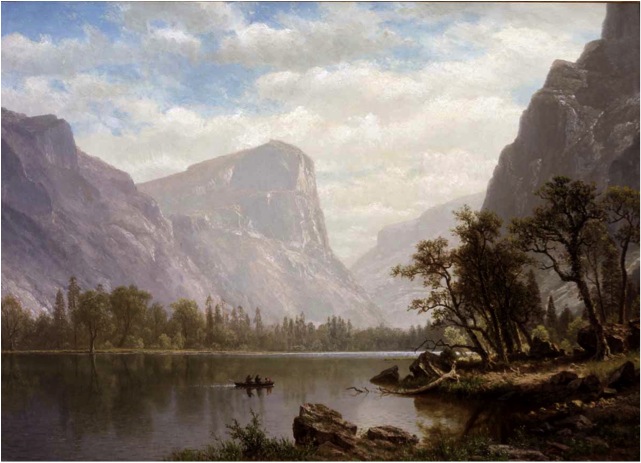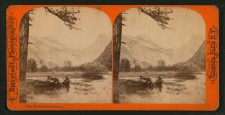
Albert Bierstadt
German, 1830-1902 (active USA)
Mirror Lake, Yosemite Valley, 1864
oil on canvas
21 3/4 x 30 1/8 in.
SBMA, Gift of Mrs. Sterling Morton for the Preston Morton Collection
1960.51

Photograph of Bierstadt taken at about age 37 by Napoleon Sarony
"Truly all is remarkable and a wellspring of amazement and wonder. Man is so fortunate to dwell in this American Garden of Eden." -- Albert Bierstadt
RESEARCH PAPER
THE ARTIST
Albert Bierstadt was born in Germany and arrived in the United States with his family when only two years old. The family settled in New Bedford, Massachusetts. Bierstadt’s artist career began when he taught monochromatic painting. He also produced art shows that demonstrated his talent for business. Despite his success in teaching and producing art shows, he knew that he would never be a really good artist until he received more training. Thanks to several benefactors, he was able to leave for Dusseldorf, a center for American artists. But once there he was unable to obtain the necessary recommendations to study with one of the star teachers of the time. Determined as he was, he pinched pennies, sent paintings home to supplement his income, trained himself in the Dusseldorf school style and traveled throughout Europe. After his return to the United States in 1859 he joined an expedition to the Wild West during which he spent seven weeks in Yosemite Valley. This was the turning point of his career. He made sketches and photographs of Native Americans and everything western, including the scenery. He completed his paintings in his New York studio. His finished pictures were usually enormous and he often combined images from different locations. His landscapes from the little known undeveloped West were very popular.
In 1871 Bierstadt and his wife visited San Francisco where they stayed for over two and half years. They met Collis Potter Huntington, a railroad baron, who commissioned several Bierstadt paintings. Ironically Huntington was one of the barons who contributed to the destruction of that same pristine west.
By 1860-1870 he reached the peak of his career and became a very well off artist. The painting “Mirror Lake” belongs to that period. After 1870, his career rapidly declined because his art no longer reflected contemporary taste.
THE ART
MIRROR LAKE – The way it was and no longer is Mirror Lake was created as a result of glaciers. Time and environmental decisions have caused silt to fill in the lake. As a result it is slowly diminishing in size. The picture of the lake reflects the actual size at the time the painting was completed. This picture is one of the first done of Yosemite Valley. The painting was done in the Hudson River style of painting stressing realism and idealism. Transcendentalism as preached by the poets Emerson, Thoreau, Alcott and others, to appreciate the glories of nature as manifestations of the divine, was also very popular. Artists of this period often reflected this philosophy in their landscapes. Bierstadt wanted to show the emphasis of the natural wonder of the majestic mountains and surrounding natural scenery. He did this by showing the landscape line up on the horizontal creating a parallel line with the picture plane along the far edge of the lake. Lines were very important in the Dusseldorf style.
The serenity of the landscape is reflected by the people sitting in a boat on a calm lake which appears as a mirror depicting divine serenity. Objects are also silhouetted against dark backgrounds to help draw the eye to the magnificent mountains. Each succeeding mountain range appears paler, bluer and less distinct because particles of moisture and dust in the atmosphere appear to have scatted the light. Blue is scattered the most, therefore the sky appears to be very blue and the mountains become bluer and hazier as one’s eyes move further into the background creating the effect of atmospheric perspective. The tiny boat and the fisherman in it emphasize the enormity of the mountains. Bierstadt completed this painting in his studio in New York by painting the foreground trees there. A steel engraving of this painting is the frontispiece for the book “Heart of the Continent.”
The picture was damaged over time but repaired in 1979.
CONCLUSION
This painting was completed at a time when America was moving rapidly westward after the gold rush and the winning of the Mexican War. America’s “Manifest Destiny” could have only been further activated by paintings like this one promoting the great beauty of the country’s western areas.
Bierstadt’s trip to Yosemite was probably the most rewarding of his career since he continued to use this beautiful area again and again in his paintings. This one was most likely instrumental in contributing to the formation of Yosemite as a National Park. Sketches and smaller paintings like this one were used by Bierstadt to create his panoramic pictures. These small paintings helped his work to regain popularity in the 1950’s and 1960’s. A retrospective exhibition of his work was shown at the Santa Barbara Museum of art in 1964.
__________________
Prepared for the Santa Barbara Museum of Art Docent Council by Denise Kightlinger, March, 2004
BIBLIOGRAPHY
Robothan, Tom, “ Albert Bierstadt,” Crescent Books 1993
Hughes, Robert: “ American Visions Epic History of Art in America”
Alfred A. Knoph, New York, 1993, pages 179, 194-198 and 555
Anderson, Nancy K., Feber, Linda S., “ Albert Bierstadt Art and Enterprise,” Hudson Hills Press, New York, 1990
Hendricks, Gordon, A. “Bierstadt 1964” Santa Barbara Museum of Art 1972
Leavitt, Thomas W., Albert Bierstadt 1830-1902 Retrospective
Exhibition, Santa Barbara Museum of Art, August 5 through September 13, 1964
Editor Marchetti, Grancesca Castria, “ American Painting”, Watson-Guptill Publications, New York 2002, pages 50-53
Editor, Mead, Katherine Harper, “The Preston Morton Collection of American Art,” Santa Barbara Museum of Art, copyright 1981, pages 104-109
Hendricks, Gordon, “ Albert Bierstadt Painter of the American West”
Harry N Abrams, Inc.
Henderson, John H. “White Mountain Art and Artists”
http: whitemountainart.com/biographics/bio ab.htm
Baigell, Matthew “Biography for the Artist Bierstadt, Albert”
http: //askart.com/biography. asp

Stereoscopic view of Mirror Lake by photographer Charles Bierstadt, Alberts older Brother. The title reflects an older spelling. Mirror view of North & South Dome, Yo Semite Val. ca.1870.
SBMA CURATORIAL LABELS
Albert Bierstadt was inspired by Carleton Watkins’ large-scale photographs of Yosemite. Such images responded to a collective appetite for the sublime in nature as a divine space untouched by the Civil War. Bierstadt created majestic views of largely inaccessible (Yosemite would not be established as a National Park until 1890) and awe-inspiring High Sierra lakes and mountains in easel-sized paintings such as this, as well as in canvases on a much grander scale in his New York City studio.
- Preston Morton Reinstallation, 2022
